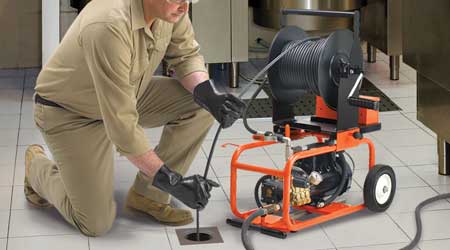How to Keep Drains Clean and Facilities Flowing
The challenge for managers and technicians is understanding the cause of the blockage and the most effective way to approach it that will help minimize the time and cost of restoring normal operations.
Drains and piping in institutional and commercial facilities are out of sight and out of mind to occupants – until something goes wrong. Roof and floor drains, restroom and commercial kitchen drains all pose a potential risk where even a small blockage can cause major disruptions to operations and thousands of dollars in damage and cleanup costs.
Fortunately, front-line technicians have an array of options when it comes to locating and removing blockages within drain lines. These options are not limited to just being reactive. With today's equipment, technicians can take steps to prevent blockages from occurring, therefore eliminating most emergency repairs and costly damage.
Maintenance and engineering managers have a number of options when it comes to specifying drain cleaning equipment that technicians use to clear building drains, including chemical, snakes, air burst, and hydro-jetting units. Not all of these options are equally effective in clearing all types of blockages.
The challenge for managers and technicians is understanding the cause of the blockage and the most effective way to approach it that will help minimize the time and cost of restoring normal operations. That understanding also can help managers establish a program of preventive maintenance for drains and piping systems.
Common causes
Proper drain-line installation is a critical factor in keeping drains operating. For example, a drain line with a slope that is too steep or too shallow increases the chances that material will accumulate in the line. Similarly, debris left over from construction that was accidentally or intentionally dumped into the building's drainage system can cause blockages that become trapping points for dirt, grease and other materials.
To troubleshoot the most common plumbing and pipe blockages, technicians can consult a building’s as-built drawings that are available from the owner or architect, which show the drain system from the fixture to the municipal sewer system and waste-treatment facility. These drawings provide an overview of the entire drainage system piping runs, both horizontal and vertical.
Technicians also need to identify the locations of inspection and cleanout plugs. They can remove the plugs, which are usually threaded into a Y-fitting, to check the condition of a pipe’s inside walls or to insert cleanout tools, inspection equipment and drain-cleaning tools.
Frequent blockage problems involve toilet and sink traps, turns and constrictions in plumbing systems. Traps serve two purposes: to hold a quantity of water between the drain opening and the sewer and prevent sewer gases from backing up into the environment, and to stop objects from becoming lodged farther into the drain line, where they are very difficult to locate and remove.
Sinks, toilets, and floor drains all have traps. Commercial kitchens have grease traps to keep large quantities of grease out of the drains. If not collected and removed periodically, the grease eventually will solidify in large enough amounts to totally block the flow through the pipe.
Some blockages also occur from penetration by tree roots into underground lines. The roots take advantage of pipe walls that have collapsed due to age or settling or that have been damaged by construction equipment inside or outside the building.
Newer low-flow toilet fixtures also can be a source of blockages, especially if the flush valves were added to the system as part of a water-conservation upgrade and if bowls were not matched to the valve's flow rate. Some older toilet bowls were not designed for lower water flow. If installation of low-flow valves did not include replacement of the old bowl design, a clogging problem might result from an insufficient water flow.
One of the most common causes of clogged floor drains in commercial and institutional buildings is water from floor mopping. Mop water contains a high level of solids and other contaminants. Over time, sludge, solids and grease can accumulate within certain areas of the piping resulting in blockages.
Commercial kitchens generate high levels of dirt, fat, oil and grease. And while most kitchens have grease receptors to prevent these contaminants from reaching the building's drains, some of them will get through, resulting in blockages over time. Even small kitchens, such as those employees use for lunch breaks, contribute the same type of contaminants to the drains, though at a lesser volume.
Recreation facilities, such as gyms and health and fitness clubs in commercial and institutional buildings, tend to introduce high levels of dirt, hair, food, mop water and soap into the drain system, all of which contribute to the formation of clogs.
Related Topics:














